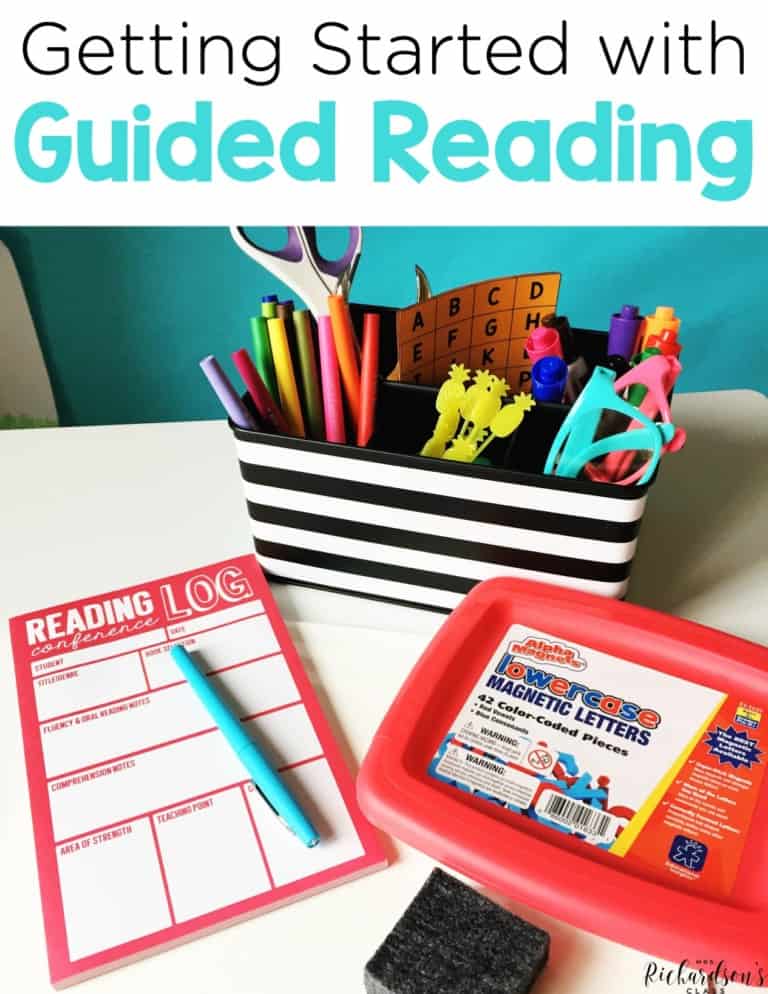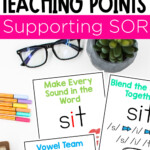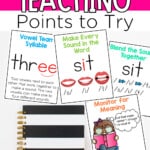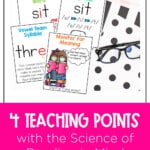

Friends, we’ve learned a lot this past year about how to best teach reading with our students. It is so important to give our students a strong phonics foundation so that they are strong, confident decoders. But how do we make sure we are prompting them and teaching them with the science of reading in mind? By providing our readers with good decoding strategies through reading small group teaching points.
First, you’ll want to take a look at your reading small groups. What do your readers need or what are they struggling with? Do some of your groups need decoding strategies? Do any of your groups need help with comprehension? Is there a group struggling with fluency?
You’ll want to know what they need help with first, so you know what to teach them. I did a blog post a few years ago that discusses the different types of teaching points. You can find that HERE!
We’ve learned so much this year about the science of reading and the importance of having students attend to print when reading. We want to make sure that when we are working with them in small group, we are asking them to attend to the text and not just the picture. Here are a few teaching points you can try to help your students with decoding!
A teaching point is NOT something that you can truly pre-plan. A good teaching point is identified as a student is reading so that you can take what they did and then coach them through it. You identify the teaching point as you are observing.
Your teaching point will last only 1-2 minutes and will be something new that the student needs to learn, not an already taught skill that he/she needs to be reminded of.
One of the first reading small group teaching points to include is to have students look at the letters when they are reading. As they look at the letters, we want them to make a sound for each letter in the word. Sometimes students will just look at the beginning of the word and guess the word based on the beginning sound. We don’t want them to do this, we want them to look at each letter and make every sound in the word.
After students make every sound in a word, we want them to blend the sounds together. They will probably blend them together slowly at first, and then faster as they keep practicing. Blending the sounds together helps them read the word.
Another reading small group teaching point to introduce is to encourage your students to look at the word and look at the vowel. We want students to use their syllable types to help them know what sound the vowel is making in the word.
I have a FREE set of syllable types posters that you can use in your classroom to help teach and remind students about syllables. Get them here!
We want to teach students the importance of monitoring their reading. We want them to read and notice if it doesn’t make sense or sound right. Then, we want to teach them to go back and look at the letters in the word again if it doesn’t make sense. We also want to encourage them to say each sound in the word to help them read the word accurately.
If you want step-by-step guidance with reading small group lessons, including teaching points, the Guided Reading Decodable Kits are for you! Each set has decodable books, detailed lesson plans, phonics practice materials, teaching posters, and more. It’s all done for you and organized in a way that’s easy to understand. You can get each set individually or grab the bundle to save.
Are you looking to learn more about bringing the science of reading research to your reading small groups? Join me in this FREE workshop!
These are just a few helpful teaching points I’ve used this year with my own kids at home to help them with decoding.
Have you had your students look at the syllable types to help them decode words? I’d love to know if you’ve tried any of the decoding strategies mentioned above or if you have some good ones of your own! Let me know in the comments. Happy teaching!

Want to use the latest research to boost your readers during small groups? This FREE guide is packed with engaging ideas to help them grow!

I’m a K-1 teacher who is passionate about making lessons your students love and that are easy to implement for teachers. Helping teachers like you navigate their way through their literacy block brings me great joy. I am a lifelong learner who loves staying on top of current literacy learning and practices. Here, you’ll find the tools you need to move your K-2 students forward!


| Cookie | Duration | Description |
|---|---|---|
| cookielawinfo-checkbox-analytics | 11 months | This cookie is set by GDPR Cookie Consent plugin. The cookie is used to store the user consent for the cookies in the category "Analytics". |
| cookielawinfo-checkbox-functional | 11 months | The cookie is set by GDPR cookie consent to record the user consent for the cookies in the category "Functional". |
| cookielawinfo-checkbox-necessary | 11 months | This cookie is set by GDPR Cookie Consent plugin. The cookies is used to store the user consent for the cookies in the category "Necessary". |
| cookielawinfo-checkbox-others | 11 months | This cookie is set by GDPR Cookie Consent plugin. The cookie is used to store the user consent for the cookies in the category "Other. |
| cookielawinfo-checkbox-performance | 11 months | This cookie is set by GDPR Cookie Consent plugin. The cookie is used to store the user consent for the cookies in the category "Performance". |
| viewed_cookie_policy | 11 months | The cookie is set by the GDPR Cookie Consent plugin and is used to store whether or not user has consented to the use of cookies. It does not store any personal data. |



2 Responses
How can I get the posters of teaching points with the Science of Reading in mind?
Hi Debbie,
You can find those posters in the Mrs. Richardson’s Class shop here: https://www.mrsrichardsonsclass.com/product/guided-reading-strategy-posters-free/
Enjoy!